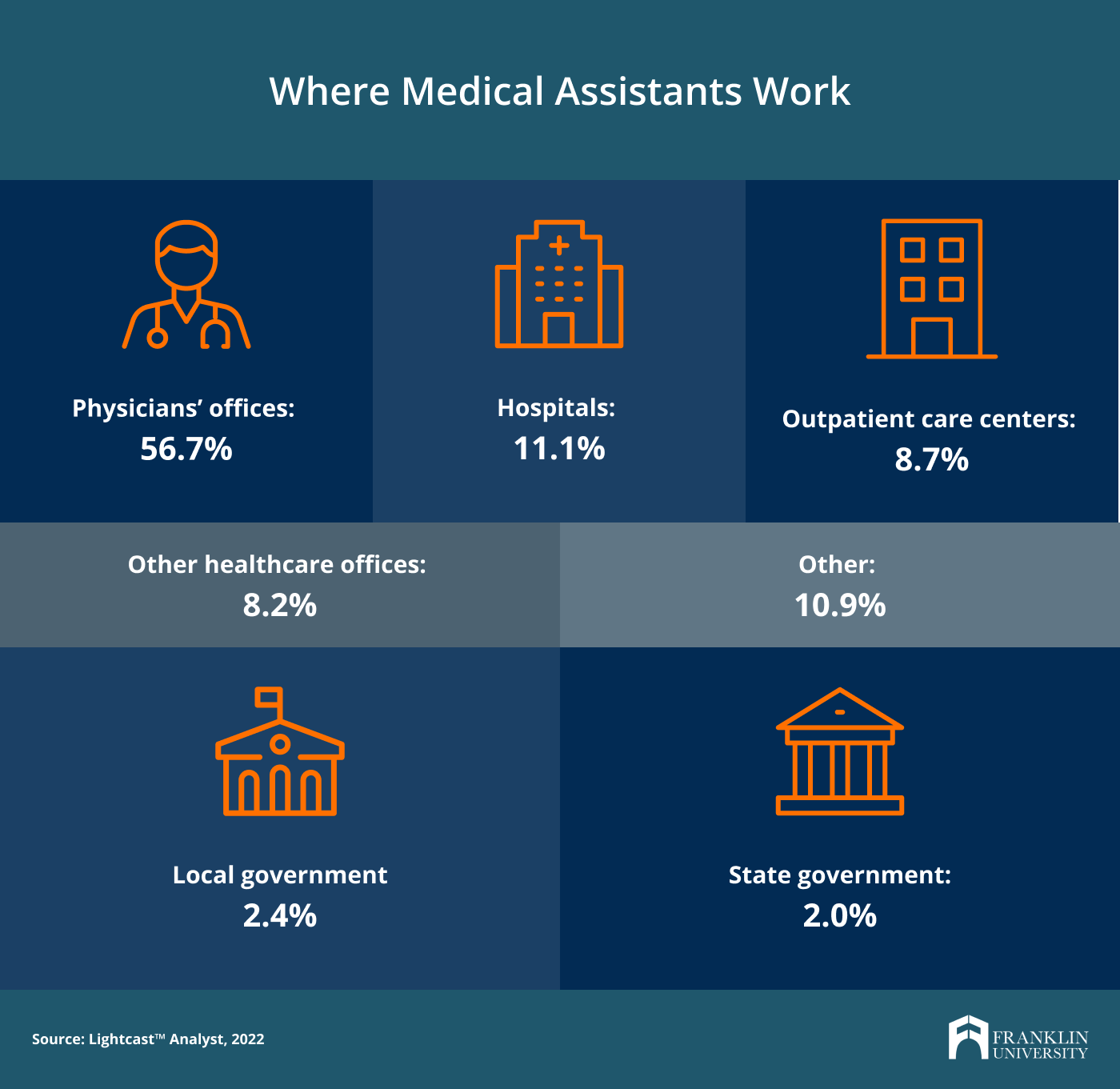Request Information
We're Sorry
There was an unexpected error with the form (your web browser was unable to retrieve some required data from our servers). This kind of error may occur if you have temporarily lost your internet connection. If you're able to verify that your internet connection is stable and the error persists, the Franklin University Help Desk is available to assist you at helpdesk@franklin.edu, 614.947.6682 (local), or 1.866.435.7006 (toll free).
Just a moment while we process your submission.

How Long Does It Take to Become a Medical Assistant?
The healthcare industry is one of the largest in the United States, and as the population grows, the need for qualified medical professionals is increasing with it. That means that healthcare jobs are always in demand.
The healthcare sector is broad and varied, but becoming a medical assistant is one of the fastest pathways into patient care. This profession is in high demand, with a 19.2% growth rate projected between now and 2032, according to Lightcast, a leading labor analytics firm. Currently, about 26,000 medical assistant jobs are advertised each month in the United States. Read on to learn how to become a medical assistant and more about what this career involves.
What Does a Medical Assistant Do?
Medical assistants work under the supervision of physicians and other practitioners in various healthcare settings. Medical assistants’ responsibilities can include clinical and/or administrative duties depending on the size and needs of the employer.
Clinical duties for medical assistants can include:
- Preparing examination rooms and taking patients to their appointments
- Sterilizing equipment and instruments
- Taking medical histories and discussing patients’ concerns
- Recording vital signs
- Collecting and handling laboratory specimens, including blood samples
- Assisting in physical examinations
- Assisting with minor procedures such as removing sutures or changing dressings
- Verifying prescriptions and administering medications and injections
- Providing patient education about medications and lifestyle
More than 26K medical assistant jobs are posted each month. Learn how you can get the knowledge and skills to become a Certified Medical Assistant online in less than one year.
Medical assistants also often provide administrative support. Duties can include:
- Scheduling appointments
- Updating patients’ medical records
- Coding medical information for billing purposes
- Processing insurance payments
- Sharing lab results with other healthcare providers
- Checking patients in and out of appointments
Where Does a Medical Assistant Work?
Medical assistants work in nearly every type of healthcare setting. They most often work in private physician practices but are also in demand in hospitals of all sizes, outpatient care centers, urgent care centers and the offices of specialist providers like chiropractors and podiatrists. Some medical assistants also work in medical laboratories, where they process patient samples, or for insurance companies, where they work on medical billing and coding.
Medical assistants’ schedules depend primarily on the setting in which they work. For example, medical assistants working in private physician practices or specialist providers may work standard business hours. In contrast, a medical assistant in a hospital or urgent care setting may take night and weekend shifts.

How Can I Become a Medical Assistant?
Unlike many other healthcare roles, you don’t need a college degree to become a medical assistant. Specific requirements vary by state, but most employers prefer to hire candidates who hold a high school diploma and have completed a medical assistant certificate program. After completing a certificate program, you can take nationally administered certification exams to demonstrate to employers that you have mastered the skills to be a medical assistant.
If you’re considering becoming a medical assistant, you should also think about whether the role fits your personality and interests.
According to Franklin University partner Cherry Mack, MSN, MS, APRN, FNP-C, director of clinical nursing and quality for PrimaryOne Health, “A good medical assistant has the ultimate goal of good consumer outcomes. In order to achieve those outcomes, a medical assistant must be compassionate, versatile, have resilience and respect diversity.”
How Long Does It Take to Become a Medical Assistant?
Medical assistant courses vary in length, with many certificate programs taking about a year to complete. According to the U.S. Bureau of Labor Statistics, associate degrees in medical assisting typically take two years. Shorter options are also available. Franklin University’s 100% online medical assistant program can be completed in as few as 5-6 months. As the program is self-paced, students may also take longer to complete the program in order if needed to balance their academic work with other personal and professional responsibilities.

What Is a Medical Assistant’s Salary?
The national median salary for a medical assistant is $37,190, according to Lightcast. Specific earnings can vary depending on region and healthcare setting. The highest-paid 25% of medical assistants in the United States earn a median salary of $43,493, while the top 10% earn $48,173.
Earn a Flexible Medical Assistant Certificate at Franklin
If you’re ready to become a medical assistant, there’s no need to wait another day. With Franklin University’s Medical Assistant Certificate program, you can start instantly and learn 100% online. While you can learn on your own schedule, most students complete the certificate program in 5-6 months.
Our curriculum, which is delivered in partnership with leading medical educator MedCerts, prepares you to take the Certified Clinical Medical Assistant (CCMA) and Certified Medical Administrative Assistant (CMAA) exams issued by the National Healthcareer Association (NHA). Instructors are experienced practitioners who teach using virtual scenarios, 3D animations, textbook readings, and more.
The medical assistant program can also help you prepare for further study in healthcare. In addition to MedCert qualifications, you can earn 13 college credits that you can apply to several healthcare degrees at Franklin University if you choose to continue your education in the future.
Ready to learn more about how Franklin can prepare you for an in-demand career as a medical assistant? Learn more about our certificate program.




